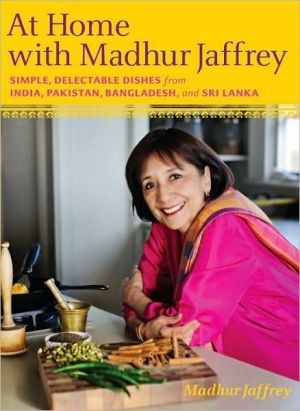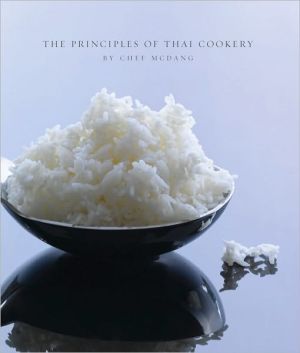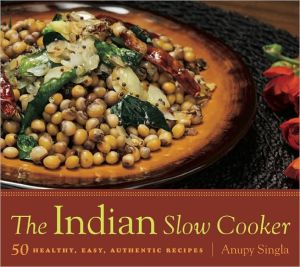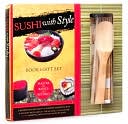At Home with Madhur Jaffrey: Simple, Delectable Dishes from India, Pakistan, Bangladesh, and Sri Lanka
For all who love the magical flavors of good Indian cooking and want to reproduce effortlessly some of the delectable dishes from that part of the world, here is a groundbreaking book from the incomparable Madhur Jaffrey that makes it possible. By deconstructing age-old techniques and reducing the number of steps in a recipe, as well as helping us to understand the nature of each spice and seasoning, she enables us to make seemingly exotic Indian dishes part of our everyday cooking.\ • First,...
Search in google:
For all who love the magical flavors of good Indian cooking and want to reproduce effortlessly some of the delectable dishes from that part of the world, here is a groundbreaking book from the incomparable Madhur Jaffrey that makes it possible. By deconstructing age-old techniques and reducing the number of steps in a recipe, as well as helping us to understand the nature of each spice and seasoning, she enables us to make seemingly exotic Indian dishes part of our everyday cooking.• First, she tantalizes us with bite-size delights to snack on with drinks or tea.• A silky soup is mellowed with coconut milk; a spinach-and-ginger soup is perfumed with cloves.• Fish and seafood are transformed by simple rubs and sauces and new ways of cooking.• A lover of eggs and chicken dishes, Jaffrey offers fresh and easy ways to cook them, including her favorite masala omelet and simple poached eggs over vegetables. There’s chicken from western Goa cooked in garlic, onion, and a splash of vinegar; from Bombay, it’s with apricots; from Delhi, it’s stewed with spinach and cardamom; from eastern India, it has yogurt and cinnamon; and from the south, mustard, curry leaves, and coconut.• There is a wide range of dishes for lamb, pork, and beef with important tips on what cuts to use for curries, kebabs, and braises.• There are vegetable dishes, in a tempting array—from everyday carrots and greens in new dress to intriguing ways with eggplant and okra—served center stage for vegetarians or as accompaniments.• At the heart of so many Indian meals are the dals, rice, and grains, as well as the little salads, chutneys, and pickles that add sparkle, and Jaffrey opens up a new world of these simple pleasures.Throughout, Madhur Jaffrey’s knowledge of and love of these foods is contagious. Here are the dishes she grew up on in India and then shared with her own family and friends in America. And now that she has made them so accessible to us, we can incorporate them confidently into our own kitchen, and enjoy the spice and variety and health-giving properties of this delectable cuisine. Publishers Weekly Legendary chef, notable actress, and prolific author Jaffrey demystifies Indian cuisine for the home cook in this appealing and flavorful collection. Jaffrey highlights dishes that are simple, straightforward, and ideal for time-pressed cooks by utilizing simpler methods and fewer steps than traditionally used. Her recipes hail mostly from India but also from southern Asia and reflect the diversity of this large geographical area. From chickpeas for nibbling or chicken mulligatawny soup to eggplant with fennel and cumin, she showcases easy-to-make dishes with readily accessible ingredients. She offers a wide array of fish and seafood dishes including spicy stir-fry shrimp, mussels in a creamy coconut sauce, and squid curry. Jaffrey also includes chapters on eggs and poultry, meat, rice and grains, and desserts. Not surprisingly, sections on vegetables, dal, and chutneys are especially tantalizing, with South Indian-style green beans, potato chaat with variations, green lentils with green beans and cilantro, black-eyed peas with butternut squash, and peanut chutney with sesame seeds. With more than 30 color photos, this book is as attractive as it is appetizing, and Jaffrey's legions of fans will eagerly embrace her newest compilation. (Oct.)
Salmon in a Bengali Mustard Sauce\ Eat this with plain rice and make the sauce as hot as you like. In Bengal, the mustard seeds are ground at home, but to make matters simpler I have used commercial ground mustard, also sold as mustard powder. You may also use halibut instead of the salmon. This very traditional dish is best served with Plain Basmati Rice, along with My Everyday Moong Dal, if you like, and a green vegetable. serves 2–3\ \ To rub on the fish:\ 3/4 pound skinless salmon fillet\ 1/4 teaspoon salt\ 1/4 teaspoon ground turmeric\ 1/4 teaspoon cayenne pepper\ \ You also need:\ 1 tablespoon ground mustard\ ¼-1/2 teaspoon cayenne pepper\ 1/4 teaspoon ground turmeric\ 1/4 teaspoon salt\ 2 tablespoons mustard oil (use extra virgin olive oil as a substitute)\ 1/4 teaspoon whole brown mustard seeds\ 1/4 teaspoon whole cumin seeds\ 1/4 teaspoon whole fennel seeds\ 2 fresh hot green and/or red chilies (bird’s-eye is best), slit slightly\ \ Cut the fish into pieces that are about 2" x 1" and rub them evenly with the salt, turmeric, and cayenne. Cover and set aside in the refrigerator for 30 minutes–10 hours. Put the mustard powder, cayenne, turmeric, and salt in a small bowl. Add 1 tablespoon water and mix thoroughly. Add another 7 tablespoons water and mix. Set aside.\ \ Pour the oil into a medium frying pan and set over medium-high heat. When hot, put in the mustard seeds. As soon as they start to pop, a matter of seconds, add the cumin and fennel seeds. Stir once and quickly pour in the mustard paste. Add the green chilies, stir, and bring to a gentle simmer. Place the fish pieces in the sauce in a single layer. Simmer gently for about 5 minutes, or until the fish is just cooked through, spooning the sauce over the fish all the time.\ Eggplants in a North-South Sauce\ This is one of our most beloved family dishes. It is very much in the Hyderabadi style, where North Indian and South Indian seasonings are combined. Over the years, I have simplified the recipe. Here, you may use the long, tender Japanese eggplants or the purple “baby” Italian eggplants or even the striated purple and white ones that are about the same size as the baby Italian ones. Once cut, what you are aiming for are 1-inch chunks with as much skin on them as possible so they do not fall apart.\ Serve this hot with meat or vegetable curries, rice, and dal or serve it cold, as a salad, with cold meats, Indian (see Chicken Karhai with Mint) or Western. I love it with slices of ham. serves 4–6\ \ 4 tablespoons olive or canola oil\ 1/8 teaspoon ground asafetida\ 1/2 teaspoon skinned urad dal or yellow split peas\ 1/2 teaspoon whole mustard seeds\ 1/2 teaspoon whole cumin seeds\ 1/2 teaspoon whole nigella seeds (kalonji)\ 1/2 teaspoon whole fennel seeds\ 1 medium onion, chopped\ 2 cloves garlic, chopped\ 1.5 pounds slim Japanese eggplants, cut crossways into 1-inch segments, or “baby” Italian eggplants cut in half lengthways and then crossways, into 1-inch segments\ 2 medium tomatoes, grated (see page 289), about 1.25 cups\ 1 cup chicken stock or water\ 1 teaspoon salt\ ¼-1/2 teaspoon cayenne pepper\ \ Pour the oil into a very large frying pan and set over medium-high heat. When hot, put in the asafetida and the urad dal. As soon as the dal turns a shade darker, add the mustard, cumin, nigella, and fennel seeds, in that order. When the mustard seeds begin to pop, a matter of seconds, add the onions. Stir and fry for a minute. Add the garlic and the eggplant. Stir and fry for 4–5 minutes or until the onions are a bit browned. Add the grated tomatoes, stock, salt, and cayenne. Stir to mix and bring to a boil. Cover, turn heat to low, and cook about 20 minutes or until the eggplants are tender, stirring now and then.\ \ Rice Pilaf with Almonds and Raisins\ Pilafs may be served at everyday meals but are grand enough for entertaining as well. If you like, you could add a generous pinch of saffron threads to the rice just before you cover it and let it simmer. You could also use chicken stock instead of the 22 cup water. serves 4–6\ \ 2 cups basmati rice\ 3 tablespoons olive or canola oil or ghee\ One 2-inch cinnamon stick\ 1/2 medium onion, sliced into fine half Rings\ 2 tablespoons slivered blanched almonds\ 2 tablespoons golden raisins\ 1 teaspoon salt\ \ Put the rice in a bowl. Wash in several changes of water. Drain. Let the rice soak in water that covers it generously for 30 minutes. Drain through a sieve and leave in the sieve suspended over a bowl to drip. Pour the oil into a heavy, medium pan (that has a tight-fitting lid) and set over medium-high heat. When hot, put in the cinnamon. Let it sizzle for 10 seconds. Put in the onions. Stir and fry the onions until they start to brown. Add the almonds. Stir until they are golden. Add the raisins. Stir until they are plump, just a few seconds. Add the drained rice and salt. Stir very gently to mix. Add 2 2/3 cups water and bring to a boil. Cover tightly, turn heat to very, very low, and simmer gently for 25 minutes
\ Publishers WeeklyLegendary chef, notable actress, and prolific author Jaffrey demystifies Indian cuisine for the home cook in this appealing and flavorful collection. Jaffrey highlights dishes that are simple, straightforward, and ideal for time-pressed cooks by utilizing simpler methods and fewer steps than traditionally used. Her recipes hail mostly from India but also from southern Asia and reflect the diversity of this large geographical area. From chickpeas for nibbling or chicken mulligatawny soup to eggplant with fennel and cumin, she showcases easy-to-make dishes with readily accessible ingredients. She offers a wide array of fish and seafood dishes including spicy stir-fry shrimp, mussels in a creamy coconut sauce, and squid curry. Jaffrey also includes chapters on eggs and poultry, meat, rice and grains, and desserts. Not surprisingly, sections on vegetables, dal, and chutneys are especially tantalizing, with South Indian-style green beans, potato chaat with variations, green lentils with green beans and cilantro, black-eyed peas with butternut squash, and peanut chutney with sesame seeds. With more than 30 color photos, this book is as attractive as it is appetizing, and Jaffrey's legions of fans will eagerly embrace her newest compilation. (Oct.)\ \ \ \ \ Library JournalJames Beard Award winner Jaffrey (Indian Cooking) explicitly spells out the goal of her new cookbook—to help readers and home cooks successfully create Indian dishes by using simplified methods and recipes. The harried pace of everyday life led her to take this approach, and she unapologetically embraces shortcuts such as using canned products and microwave ovens. The recipes are generally under one page in length, and many of the ingredients will be readily found without resorting to specialty stores. Jaffrey establishes that she intends to hold the reader's hand, and while this sometimes results in a grandmotherly tone and cozily subjective descriptions (What makes paprika "nice"?), it is likely that readers will find many easy gems to enjoy time and again. VERDICT An accessible and approachable set of recipes with dishes to suit every taste. This could also be a springboard to more complex cooking for the adventuresome.—Peter Hepburn, Univ. of Illinois at Chicago\ \








